Uzbekistan, Turkmenistan & Kyrgyzstan Trip
17 Days Private Tour of Tashkent - Khiva - Kunya Urgench - Darvaza - Ashgabat - Mary - Bukhara - Samarkand - Tashkent - Osh - Bishkek - Chon Kemin - Cholpon Ata - Burana Tower - Bishkek
Tour Type: Private guided tour, flexible and customizable
Transportation: Air-conditioned private car with experienced driver
Accommodation: 3 to 4 stars well-selected hotels & camps, open to your choice
Meals: 16 breakfasts and 1 dinner
Code: TCA104
Transportation: Air-conditioned private car with experienced driver
Accommodation: 3 to 4 stars well-selected hotels & camps, open to your choice
Meals: 16 breakfasts and 1 dinner
Code: TCA104
This trip can be customized to meet your individual needs!
Free InquiryGet our reply within 24 hours!
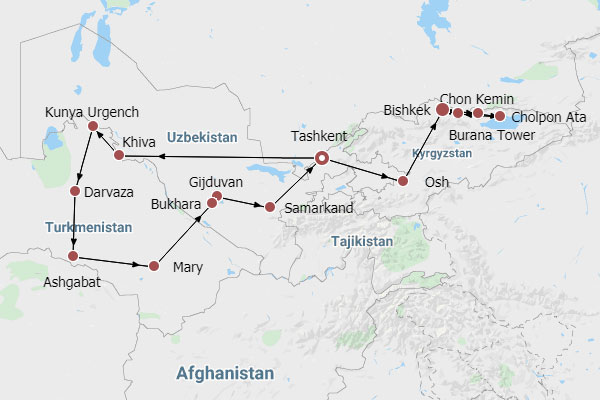
- Itinerary
- Reviews
Trip Highlights
- Wander among Samarkand’s numerous blue monuments and find how it reemerged as a metropolis under Timur’s rule.
- Immerse yourself in the mysterious desert night with the surreal flaming Darvaza Gas Crater, aka the ‘Door to Hell’.
- Admire panoramic views of Khiva’s over 200 historic structures at the top of Kunya-Ark and the Islam Khodja Minaret.
- Hike in the Ala Archa National Park in Kyrgyzstan to enjoy a moment of solitude with nature.
- Explore the silk production process and appreciate carpet weaving art at Margilan.
Expand All
Collapse All
Day 1 Arrive in Tashkent, Uzbekistan; Airport Pick-up
Welcome to our 17 days Uzbekistan Turkmenistan Kyrgyzstan tour package! After landing in Tashkent, the capital of Uzbekistan, you’ll meet our driver at the airport and enjoy a private transfer in an air-conditioned car to the downtown hotel for check-in. The rest of the day is free for you.
Uzbekistan was once the heart of the ancient Silk Road, nurturing many thriving cities like Samarkand, Khiva, and Bukhara. During the Timurid Empire (1370-1570), grand minarets, gorgeous mosques, and bustling bazaars emerged, covering the scars left by the 13th-century Mongol invasion. Follow our guide to step back in time to unveil the country’s treasures in the next few days. An e-visa is required for visiting Uzbekistan, and you can apply for a double-entry visa online for USD 35, as we’ll cross the Uzbek border twice on this itinerary.
► Please Note:
1. Currency: We recommend carrying US dollars to enter Uzbekistan and Kyrgyzstan and exchanging them for local som as needed, since Visa and MasterCard are only accepted in some major hotels, restaurants, and malls.
2. Road condition: This itinerary involves some bumpy roads and long driving times when traveling through deserts, basins, and high-altitude mountain ranges, so you are recommended to pack motion sickness pills, a U-shaped pillow, earplugs, and a mask.
Accommodation: Wyndham Tashkent (4 stars) or similar
Uzbekistan was once the heart of the ancient Silk Road, nurturing many thriving cities like Samarkand, Khiva, and Bukhara. During the Timurid Empire (1370-1570), grand minarets, gorgeous mosques, and bustling bazaars emerged, covering the scars left by the 13th-century Mongol invasion. Follow our guide to step back in time to unveil the country’s treasures in the next few days. An e-visa is required for visiting Uzbekistan, and you can apply for a double-entry visa online for USD 35, as we’ll cross the Uzbek border twice on this itinerary.
► Please Note:
1. Currency: We recommend carrying US dollars to enter Uzbekistan and Kyrgyzstan and exchanging them for local som as needed, since Visa and MasterCard are only accepted in some major hotels, restaurants, and malls.
2. Road condition: This itinerary involves some bumpy roads and long driving times when traveling through deserts, basins, and high-altitude mountain ranges, so you are recommended to pack motion sickness pills, a U-shaped pillow, earplugs, and a mask.
Accommodation: Wyndham Tashkent (4 stars) or similar
Day 2 Fly from Tashkent to Khiva: Ichan Kala, Kalta Minor Minaret, Juma Mosque, Islam Khodja Minaret
In the morning, you’ll be transferred to the airport for a 1.5-hour flight to Khiva. Upon arrival, a local driver will pick you up and escort you to the hotel. After check-in, our guide will show you around this over 1,500-year-old city. According to legend, when a caravan passed by Khiva along the ancient Silk Road, they drank water from a well and were surprised to say “hei-vakh”, which literally means “How wonderful”, so the well and its surrounding settlements were then named Khiva.
Our first stop is the Ichan Kala, Khiva’s inner city, which is relatively well-preserved, surrounded by its massive and robust city walls. The narrow alleys are car-free, so you can slow down to observe local life in the clay-colored houses. Apart from its simple beauty, the city presents vibrant pops of color with turquoise-glazed tiles on the façades of Muhammad Aminkhan Madrasah, Muhammad Rahim Khan Madrasah, and Kalta Minor Minaret.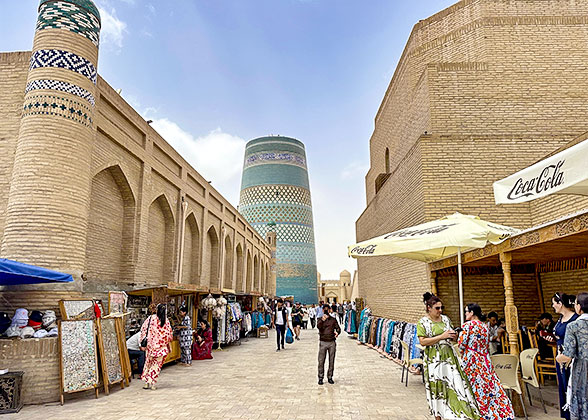
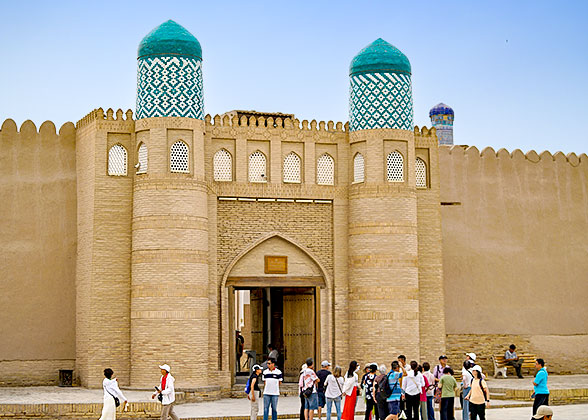 Then, we’ll head to the Juma Mosque. Unlike other mosques with huge domes, it attracts you with 212 wooden pillars carved with Arabic characters and Islamic patterns, which have been well-preserved for thousands of years thanks to the camel wool pad between the columns’ ends and their stone bases. After visiting the Tosh-Hovli Palace, a former royal residence where the Khan and his concubines lived, go to the Pahlavan Mahmud Mausoleum, dedicated to a famous Uzbek poet who was also good at wrestling. Conclude today’s sightseeing with panoramic views of Khiva from the top of Kunya-Ark and the Islam Khodja Minaret; the latter is Khiva’s tallest minaret, at 57 meters (187 feet) tall, characterized by alternating strips of glazed tiles in blue, white, and turquoise hues. Afterward, you’ll be whisked back to the hotel.
Then, we’ll head to the Juma Mosque. Unlike other mosques with huge domes, it attracts you with 212 wooden pillars carved with Arabic characters and Islamic patterns, which have been well-preserved for thousands of years thanks to the camel wool pad between the columns’ ends and their stone bases. After visiting the Tosh-Hovli Palace, a former royal residence where the Khan and his concubines lived, go to the Pahlavan Mahmud Mausoleum, dedicated to a famous Uzbek poet who was also good at wrestling. Conclude today’s sightseeing with panoramic views of Khiva from the top of Kunya-Ark and the Islam Khodja Minaret; the latter is Khiva’s tallest minaret, at 57 meters (187 feet) tall, characterized by alternating strips of glazed tiles in blue, white, and turquoise hues. Afterward, you’ll be whisked back to the hotel.
► Activity Suggestion:
Once revitalized, consider venturing out by yourself to watch a stunning sunset, a must-do in Khiva! You can ascend to the southern city wall of the Ichan Kala, which is the best viewing point and photography spot. Another good place to take in the sunset is some restaurants’ terraces, like Khiva Moon, but it’s better to reserve a table in advance.
Meals: Breakfast
Accommodation: Hotel Asia Khiva (3 stars) or similar
Our first stop is the Ichan Kala, Khiva’s inner city, which is relatively well-preserved, surrounded by its massive and robust city walls. The narrow alleys are car-free, so you can slow down to observe local life in the clay-colored houses. Apart from its simple beauty, the city presents vibrant pops of color with turquoise-glazed tiles on the façades of Muhammad Aminkhan Madrasah, Muhammad Rahim Khan Madrasah, and Kalta Minor Minaret.

Kalta Minor Minaret, Khiva

Ichan Kala of Khiva
► Activity Suggestion:
Once revitalized, consider venturing out by yourself to watch a stunning sunset, a must-do in Khiva! You can ascend to the southern city wall of the Ichan Kala, which is the best viewing point and photography spot. Another good place to take in the sunset is some restaurants’ terraces, like Khiva Moon, but it’s better to reserve a table in advance.
Meals: Breakfast
Accommodation: Hotel Asia Khiva (3 stars) or similar
Day 3 Transfer to Kunya-Urgench, Turkmenistan; Drive 5 Hours to Darvaza Gas Crater
Today, you’ll be transferred to the border of Uzbekistan and Turkmenistan. Given the long travel time of today’s itinerary, we advise packing some snacks to keep your energy up. After crossing the border, our Turkmen guide and the driver will escort you to visit the Kunya-Urgench Historical Park.
Kunya-Urgench once thrived as the capital of the Khwarazmian Empire (1077-1231) and was deemed one of the most beautiful cities in the East before it was devastated by Genghis Khan in the 13th century. Legend has it that to capture its wealth, every Mongol soldier hoped to lead two horses or more, loaded with silk clothes, gemstone necklaces, and other rare items, and took home skilled slaves to sew boots and fur coats. Nowadays, you can trace its past glory through the remaining mosques, minarets, and mausoleums. Among these lies the Nedjmeddin Kubra Mausoleum, where an illustrious Sufi teacher and poet is buried, attracting pilgrims who believe in his miraculous healing power.
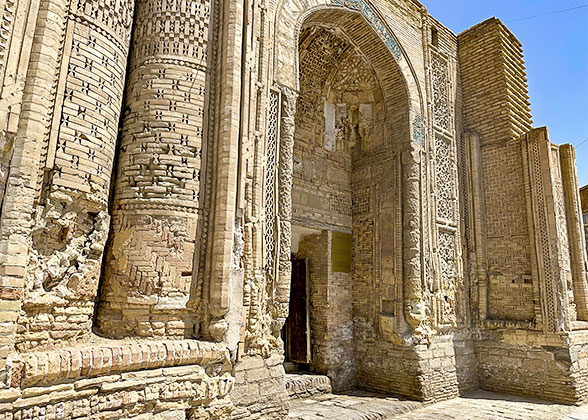
► Essential Tips for Your Turkmenistan Tour:
1. All visitors to Turkmenistan are required to obtain a tourist visa by acquiring a Letter of Invitation from a licensed travel agency, and independent travel is not permitted. We will provide the LOI and a carefully tailored itinerary to ensure you have a smooth journey.
2. Turkmenistan has scarce ATMs and exchange bureaus, and most places don’t accept credit cards, so please ensure you bring US dollars in cash to cover all your expenses in the country, including the visa on arrival fee and the immigration fee when crossing the border.
3. Leave the Internet world behind, as WhatsApp, Facebook, and Instagram are unavailable in Turkmenistan. However, you can take a digital detox and focus on the genuine travel experience.
Meals: Breakfast, Dinner
Accommodation: Yurt camp in Darvaza
Kunya-Urgench once thrived as the capital of the Khwarazmian Empire (1077-1231) and was deemed one of the most beautiful cities in the East before it was devastated by Genghis Khan in the 13th century. Legend has it that to capture its wealth, every Mongol soldier hoped to lead two horses or more, loaded with silk clothes, gemstone necklaces, and other rare items, and took home skilled slaves to sew boots and fur coats. Nowadays, you can trace its past glory through the remaining mosques, minarets, and mausoleums. Among these lies the Nedjmeddin Kubra Mausoleum, where an illustrious Sufi teacher and poet is buried, attracting pilgrims who believe in his miraculous healing power.

Darvaza Gas Crater

Kunya Urgench
★ Darvaza Gas Crater: Methane’s Unyielding Dance
Then adventure awaits at the Darvaza Gas Crater, more well-known as the ‘Door to Hell’, and after a 5-hour drive, you’ll feel the heat of this surreal phenomenon. Thousands of flames dance like angry spirits at night, looking impressive against the stark desert, even with fences around it. When approaching, you’ll hear the rumble of fire, which is intimidating and fascinating. Shoot this unforgettable moment with your guide’s help, where the flickering flames illuminate your silhouette, creating the illusion that you’re the sole survivor in a mystical world. To wrap up your day, enjoy a BBQ dinner and spend the night at a nearby yurt camp, complete with a sleeping mat, a sleeping bag, and a pillow, allowing you to rest under twinkling stars.► Essential Tips for Your Turkmenistan Tour:
1. All visitors to Turkmenistan are required to obtain a tourist visa by acquiring a Letter of Invitation from a licensed travel agency, and independent travel is not permitted. We will provide the LOI and a carefully tailored itinerary to ensure you have a smooth journey.
2. Turkmenistan has scarce ATMs and exchange bureaus, and most places don’t accept credit cards, so please ensure you bring US dollars in cash to cover all your expenses in the country, including the visa on arrival fee and the immigration fee when crossing the border.
3. Leave the Internet world behind, as WhatsApp, Facebook, and Instagram are unavailable in Turkmenistan. However, you can take a digital detox and focus on the genuine travel experience.
Meals: Breakfast, Dinner
Accommodation: Yurt camp in Darvaza
Day 4 Drive 4 Hours to Ashgabat: Visit Akhal-Teke Horse Stable, Carpet Museum, and Teke Bazaar
After breakfast, our guide and the driver will escort you to Ashgabat in 4 hours, with a stop at Seyit Jemaletdin Mosque Ruins along the way. We’ll also meet Akhal-Teke horses at a horse stable, known for their pretty fur, elegant appearance, and imposing endurance. Surprisingly, in 1935, 15 horses traveled 960 km (597 miles) through the Karakum Desert without food and water, proving their endurance and importance to Turkmen nomadic life. If you want to experience riding such a horse, feel free to ask the stable owner for details and expenses.
Upon arrival at Ashgabat, continue our journey at the Turkmen Carpet Museum and dive into the artistry behind over 2,000 colorful textiles. Apart from their aesthetic value, carpets were originally used as signals by herders because yurts didn’t have locks. When they hung the carpet vertically on the door, it meant no one was in the tent, and when they rolled it up high, it meant guests could enter. Next, you’ll glimpse the local life at Teke Bazaar, which sells daily necessities, fruits, and vegetables. The aroma of various local specialties also fills the air, such as Pishme, Turkmen doughnuts made salty or drizzled in sugar, and Gutap, a salty pastry stuffed with minced meat, spinach, pumpkin, and onions. You can try them at your own expense if interested. Finally, we’ll transfer you to the hotel.
Meals: Breakfast
Accommodation: Sport Hotel Ashgabat (4 stars) or similar
Upon arrival at Ashgabat, continue our journey at the Turkmen Carpet Museum and dive into the artistry behind over 2,000 colorful textiles. Apart from their aesthetic value, carpets were originally used as signals by herders because yurts didn’t have locks. When they hung the carpet vertically on the door, it meant no one was in the tent, and when they rolled it up high, it meant guests could enter. Next, you’ll glimpse the local life at Teke Bazaar, which sells daily necessities, fruits, and vegetables. The aroma of various local specialties also fills the air, such as Pishme, Turkmen doughnuts made salty or drizzled in sugar, and Gutap, a salty pastry stuffed with minced meat, spinach, pumpkin, and onions. You can try them at your own expense if interested. Finally, we’ll transfer you to the hotel.
Meals: Breakfast
Accommodation: Sport Hotel Ashgabat (4 stars) or similar
Day 5 Ashgabat: Ertugul Gazi Mosque, National History Museum, Parthian Fortresses of Nisa
Kick-off today’s Ashgabat tour at the Ertugrul Gazi Mosque. As one of the country’s largest mosques, it is funded by Turkey to celebrate Turkmenistan’s independence from the Soviet Union (1922-1991). The mosque’s giant dome and soaring minarets, as well as stained glass windows and chandeliers, echo the beauty of Istanbul’s Blue Mosque.
Then you’ll be accompanied to Independence Park and see the city’s highest building, the Monument of Independence. Our next stop is the Arch of Neutrality, built to commemorate Turkmenistan’s neutral position, which helped it emerge from Central Asia’s turbulent situation after the Soviet Union’s dissolution. We’ll also pay a visit to the National History Museum, which houses artifacts and archeological findings dating back to 50,000 BC and exhibits from Ashgabat’s surrounding areas, including ceramic decorations, rare minerals, and bone sculptures.
After visiting the Turkmenbashy Ruhy Mosque and Mausoleum, dedicated to the former president Niyazov, let’s go to the Parthian Fortresses of Nisa. Built in the 3rd century, this site blends history and art into its architecture, with two distinct parts: New Nisa and Old Nisa. New Nisa was once the pivotal granary and handicraft market thriving along the ancient Silk Road, guarded by 9-meter (30-foot) tall city walls; however, now you can only see its foundations since it has not been fully excavated. We’ll mainly explore Old Nisa, a pentagonal royal fortress on a small hill, and you can see its panoramic views from the platform near the entrance. One of the most important monuments is the Square Hall, where you can see niches on its upper walls that once displayed clay statues of men in cloaks and women in white robes, hinting at its former use as an Iranian fire temple for rituals. Then you’ll be transferred to the hotel.
Meals: Breakfast
Accommodation: Sport Hotel Ashgabat (4 stars) or similar
Then you’ll be accompanied to Independence Park and see the city’s highest building, the Monument of Independence. Our next stop is the Arch of Neutrality, built to commemorate Turkmenistan’s neutral position, which helped it emerge from Central Asia’s turbulent situation after the Soviet Union’s dissolution. We’ll also pay a visit to the National History Museum, which houses artifacts and archeological findings dating back to 50,000 BC and exhibits from Ashgabat’s surrounding areas, including ceramic decorations, rare minerals, and bone sculptures.
After visiting the Turkmenbashy Ruhy Mosque and Mausoleum, dedicated to the former president Niyazov, let’s go to the Parthian Fortresses of Nisa. Built in the 3rd century, this site blends history and art into its architecture, with two distinct parts: New Nisa and Old Nisa. New Nisa was once the pivotal granary and handicraft market thriving along the ancient Silk Road, guarded by 9-meter (30-foot) tall city walls; however, now you can only see its foundations since it has not been fully excavated. We’ll mainly explore Old Nisa, a pentagonal royal fortress on a small hill, and you can see its panoramic views from the platform near the entrance. One of the most important monuments is the Square Hall, where you can see niches on its upper walls that once displayed clay statues of men in cloaks and women in white robes, hinting at its former use as an Iranian fire temple for rituals. Then you’ll be transferred to the hotel.
Meals: Breakfast
Accommodation: Sport Hotel Ashgabat (4 stars) or similar
Day 6 Fly to Mary: Ancient Merv & Mary Regional Museum; Drive to Bukhara, Uzbekistan
After breakfast, you’ll be escorted to the airport for a 40-minute flight to Mary. Upon arrival, our driver and the guide will pick you up and lead you to Ancient Merv, an oasis city dating back to the 6th century BC. We’ll visit the State Historical and Cultural Park, home to unique structures from the 6th to the 18th centuries, where the Mohammed ibn-Zeid Mausoleum, Kesk Fortresses, and Sultan Sanjar Mausoleum showcase the architectural wisdom of the bygone era. The remarkably well-preserved Sultan Sunjar Mausoleum best represents Merv’s past glory, with its 5-meter (16-foot) thick wall resisting the fierce Mongols’ attacks. Archaeologists have restored its octagonal, star-shaped dome, which was once decorated with blue-glazed tiles and geometric mosaics.
 Ancient Merv - Destroyed by Genghis Khan’s Forces
Ancient Merv - Destroyed by Genghis Khan’s Forces
The oasis city reached its heyday in the 12th century, when Buddhism, Zoroastrianism, and Christianity thrived, forming a diverse community of thinkers and scholars. However, all changed in the 13th century when Genghis Khan’s son, Tolui, invaded with an army of 70,000 troops, leading to a catastrophic siege. Within a year, nearly a million lives were lost, and only 400 skilled craftsmen were spared.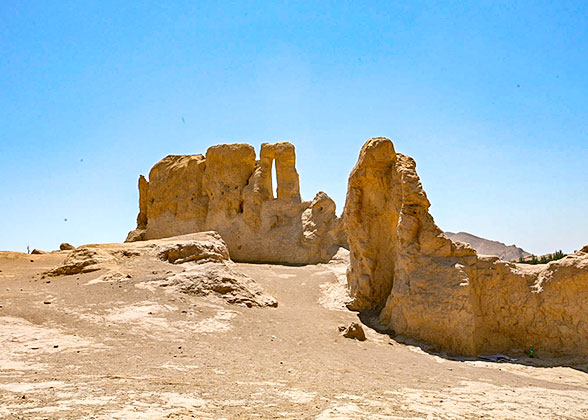
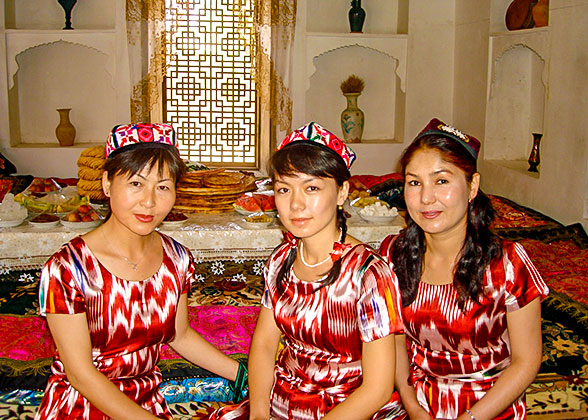 After that, drive back to Mary to visit the Mary Regional Museum, and then we’ll escort you to the Uzbek border. After finishing frontier formalities, our local driver will escort you to the hotel in Bukhara for check-in. Once settled, you can head out by yourself to discover the handicrafts workshop of Suzani, which are embroideries crafted from a cotton or silk base with floral and vine patterns, and used as tapestries or blankets by locals.
After that, drive back to Mary to visit the Mary Regional Museum, and then we’ll escort you to the Uzbek border. After finishing frontier formalities, our local driver will escort you to the hotel in Bukhara for check-in. Once settled, you can head out by yourself to discover the handicrafts workshop of Suzani, which are embroideries crafted from a cotton or silk base with floral and vine patterns, and used as tapestries or blankets by locals.
Meals: Breakfast
Accommodation: Volida Hotel Bukhara (3 stars) or similar
The oasis city reached its heyday in the 12th century, when Buddhism, Zoroastrianism, and Christianity thrived, forming a diverse community of thinkers and scholars. However, all changed in the 13th century when Genghis Khan’s son, Tolui, invaded with an army of 70,000 troops, leading to a catastrophic siege. Within a year, nearly a million lives were lost, and only 400 skilled craftsmen were spared.

Ancient Merv Historical Park

Local People in Turkmenistan
Meals: Breakfast
Accommodation: Volida Hotel Bukhara (3 stars) or similar
Day 7 Bukhara: Kalyan Minaret & Mosque, Lyabi Hauz Ensemble, Chor-Minor Madrasah
Today, follow our guide on a walking tour of Bukhara, a city with over 2,500 years of history shaped by various civilizations, from the Samanids and the Mongols to the Timurids. Since Islam flourished in the 7th century, thousands of mosques and madrasahs were built here, leaving numerous spiritual legacies and architectural wonders.
Our first stop is the Kalyan Minaret, a 47-meter (154-foot) high conical structure with 14 decorative brick stripes, including an eye-catching band of blue enamel tiles. It was originally used to convene Muslims for prayer and later served as a watchtower during wartime. According to the legend, it was here that Genghis Khan justified his invasion of Bukhara by claiming himself the “scourge of God”.
Next to the minaret are the Kalyan Mosque and Miri-Arab Madrasah, where you can marvel at how they frame botanical and geometric patterns, as well as Arabic inscriptions! Opposite, the Magoki-Attori Mosque was once a Zoroastrian temple that survived the 13th-century Mongol invasion because the locals at that time buried it in sand beneath the ground for 6 meters (20 feet). Now, it is a small carpet museum. Then, the more splendid Abdulaziz Khan Madrassah will showcase all the decorative techniques, such as carved tiles, marble sculptures, and ornate gilding.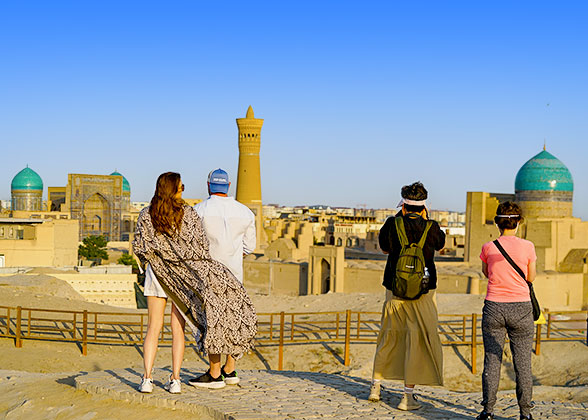
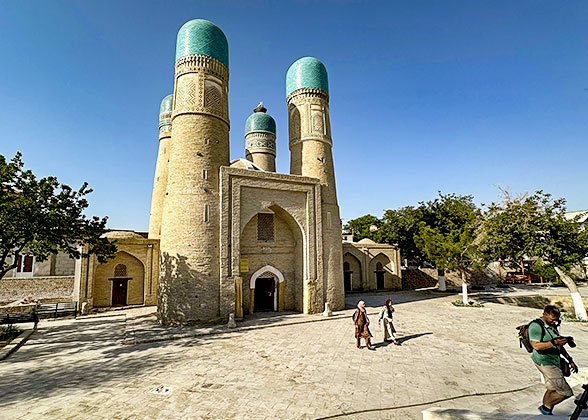 You’ll also visit the Trade Domes Market, which teems with vendors selling souvenirs like handwoven carpets, painted metallic utensils, and exquisite jewelry. Following that, let’s dive into Bukhara’s beating heart, the Lyabi Hauz Ensemble, where you may see locals playing chess and tourists taking photos with the statue of Khoja Nasreddin, a folk figure who rides a donkey in short and funny anecdotes popular among Central Asia. Don’t hesitate to join them! Behind this ensemble is the Chor-Minor Madrasah, where four blue-domed minarets like buds of flowers surround an open platform, making it stand out from its counterparts and grace the cover of Lonely Planet. After that, you’ll be escorted back to the hotel.
You’ll also visit the Trade Domes Market, which teems with vendors selling souvenirs like handwoven carpets, painted metallic utensils, and exquisite jewelry. Following that, let’s dive into Bukhara’s beating heart, the Lyabi Hauz Ensemble, where you may see locals playing chess and tourists taking photos with the statue of Khoja Nasreddin, a folk figure who rides a donkey in short and funny anecdotes popular among Central Asia. Don’t hesitate to join them! Behind this ensemble is the Chor-Minor Madrasah, where four blue-domed minarets like buds of flowers surround an open platform, making it stand out from its counterparts and grace the cover of Lonely Planet. After that, you’ll be escorted back to the hotel.
Meals: Breakfast
Accommodation: Volida Hotel Bukhara (3 stars) or similar
Our first stop is the Kalyan Minaret, a 47-meter (154-foot) high conical structure with 14 decorative brick stripes, including an eye-catching band of blue enamel tiles. It was originally used to convene Muslims for prayer and later served as a watchtower during wartime. According to the legend, it was here that Genghis Khan justified his invasion of Bukhara by claiming himself the “scourge of God”.
Next to the minaret are the Kalyan Mosque and Miri-Arab Madrasah, where you can marvel at how they frame botanical and geometric patterns, as well as Arabic inscriptions! Opposite, the Magoki-Attori Mosque was once a Zoroastrian temple that survived the 13th-century Mongol invasion because the locals at that time buried it in sand beneath the ground for 6 meters (20 feet). Now, it is a small carpet museum. Then, the more splendid Abdulaziz Khan Madrassah will showcase all the decorative techniques, such as carved tiles, marble sculptures, and ornate gilding.

Kalyan Minaret, Bukhara

Chor-Minor Madrasah, Bukhara
Meals: Breakfast
Accommodation: Volida Hotel Bukhara (3 stars) or similar
Day 8 Bukhara: Ark Fortress, Bolo Hauz Mosque, Samanid Mausoleum; High-speed Train to Samarkand
Continue to explore Bukhara after breakfast, starting with the Ark Fortress, built in the 4th century BC. Beyond its defensive role, it was also the royal residence for Emirs, Bukhara’s governors, until it fell into Russian hands in 1920. Located in the fortress’s eastern part, there is one chilling spot, the “bug pit” in the Zinda Prison, where prisoners were lowered on a rope and left in a deep pit covered with iron fences. As its name suggests, you won’t want to know how they struggled to live with rats and bugs.
Afterward, let’s walk to the opposite Bolo Hauz Mosque, and you’ll be enchanted by the 20 exquisitely carved pillars at the entrance, which is certainly a rare sight in wood-scarce Central Asia. Our next stop is the Samanid Mausoleum, which features a cubic shape made of ochre-yellow fired bricks in different hollowed patterns, such as diamonds, coins, and wickerwork, creating a variety of light play on the ground. Then move to the nearby Chashma Ayub Mausoleum, dedicated to the prophet who brought water to Bukhara. Tourists are often encouraged to sip water from the well there, as many believe it has the power to cure diseases.
Leave the old city behind, and we’ll head to the Summer Palace (Sitori Mokhi Khosa Palace) in Bukhara’s northern suburb. It’s the residence of Bukhara’s last Emir, and you’ll find a fusion of traditional Islamic design and elegant Russian neoclassical elements, relative to the Emir’s educational experience in Russia. Today’s sightseeing will conclude at the Memorial Complex of Bahouddin Naqshband, where you could learn more about Sufism by perusing ancient clothing, sacred texts, and prayer blankets in the museum.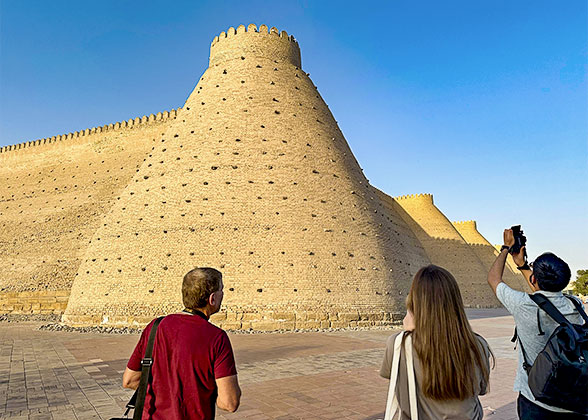
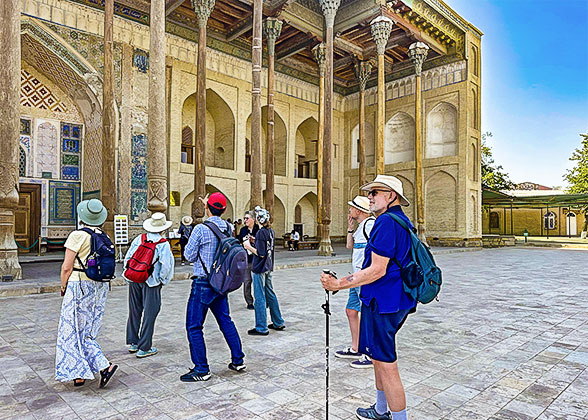 Next, you’ll be escorted to the train station for a 2-hour high-speed train to Samarkand and check into the local hotel.
Next, you’ll be escorted to the train station for a 2-hour high-speed train to Samarkand and check into the local hotel.
► Dinner Suggestion in Samarkand (at your own expense):
If you’re tired of touristy restaurants, consider trying authentic local meals at the Shokhrukh Nur Restaurant, which blends traditional Eastern motifs with a modern atmosphere. Maybe you’ll love their Grilled Lamb Tenderloin, featuring a crunchy crust while staying juicy and tender inside. For a lighter option, try their baked potatoes and vegetable soup.
Average Cost per Person: UZS 50,000-100,000 (USD 4-8)
Address: MX3H+542, Samarkand, Samarkand Region, Uzbekistan
Meals: Breakfast
Accommodation: Grand Samarkand Superior (4 stars) or similar
Afterward, let’s walk to the opposite Bolo Hauz Mosque, and you’ll be enchanted by the 20 exquisitely carved pillars at the entrance, which is certainly a rare sight in wood-scarce Central Asia. Our next stop is the Samanid Mausoleum, which features a cubic shape made of ochre-yellow fired bricks in different hollowed patterns, such as diamonds, coins, and wickerwork, creating a variety of light play on the ground. Then move to the nearby Chashma Ayub Mausoleum, dedicated to the prophet who brought water to Bukhara. Tourists are often encouraged to sip water from the well there, as many believe it has the power to cure diseases.
Leave the old city behind, and we’ll head to the Summer Palace (Sitori Mokhi Khosa Palace) in Bukhara’s northern suburb. It’s the residence of Bukhara’s last Emir, and you’ll find a fusion of traditional Islamic design and elegant Russian neoclassical elements, relative to the Emir’s educational experience in Russia. Today’s sightseeing will conclude at the Memorial Complex of Bahouddin Naqshband, where you could learn more about Sufism by perusing ancient clothing, sacred texts, and prayer blankets in the museum.

Ark Fortress, Bukhara

Bolo Hauz Mosque, Bukhara
► Dinner Suggestion in Samarkand (at your own expense):
If you’re tired of touristy restaurants, consider trying authentic local meals at the Shokhrukh Nur Restaurant, which blends traditional Eastern motifs with a modern atmosphere. Maybe you’ll love their Grilled Lamb Tenderloin, featuring a crunchy crust while staying juicy and tender inside. For a lighter option, try their baked potatoes and vegetable soup.
Average Cost per Person: UZS 50,000-100,000 (USD 4-8)
Address: MX3H+542, Samarkand, Samarkand Region, Uzbekistan
Meals: Breakfast
Accommodation: Grand Samarkand Superior (4 stars) or similar
Day 9 Samarkand: Registan Square, Gur-Emir Mausoleum; High-speed Train to Tashkent
Today is devoted to unveiling Samarkand, the most famous ancient Silk Road city. It originated in 650 BC and flourished as a metropolis during the Timurid Empire (1370-1507), when Timur enslaved master craftsmen from across Central Asia to rebuild the city after the 13th-century Mongol invasion. His grandson, Ulugh Beg, who made remarkable achievements in astronomy and mathematics, further established Samarkand as a hub of knowledge.
Our guide will accompany you to the Registan Square first, composed of the three most splendid madrasahs in Samarkand; the largest of which, the Tillya Kori Madrasah, will amaze you with its gold inlay on the altar made from filigree that is 7 times thinner than a human hair! Next, meander forward to Samarkand’s largest bazaar, Siyob Bazaar, where vendors sell everything from hats to nuts and spices under a corrugated iron sheet roof.
Followed by a visit to the Bibi Khanym Mosque, which is said to rival the Heavenly Palace with its beautiful dome. At the entrance, the vault symbolizes the Milky Way, offering a surreal gateway to this sacred space. Unfortunately, most of the mosaics and murals were destroyed due to the hasty construction and a great earthquake, and what you see today is the building’s restored version.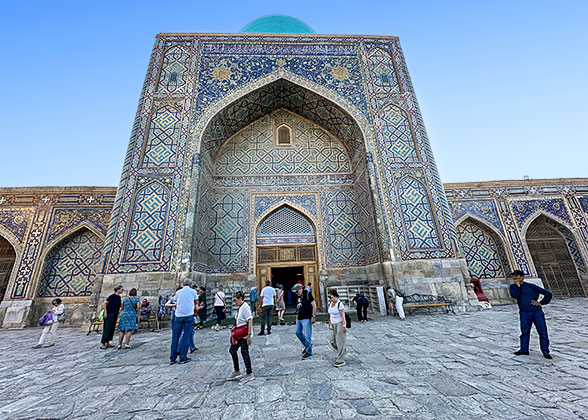
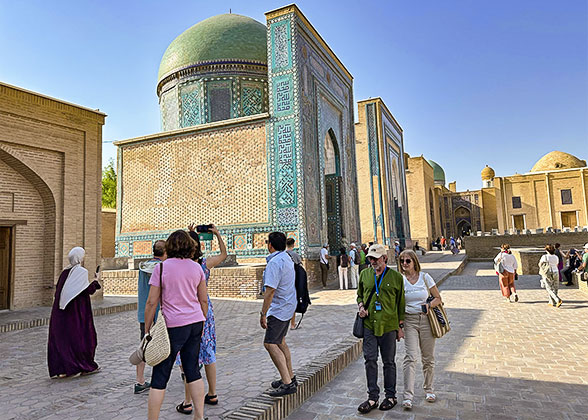 After paying tribute to the early astronomical achievements of the brass sextant at the Ulugbek Observatory, let’s make our way to the Shah-i-Zinda Necropolis, which is a site that remains untouched and reflects the authentic luxury of old Samarkand. You’ll see turquoise and blue glazed tiles inscribed with memorial Islamic calligraphy, replacing the traditional carved clay on the façade.
After paying tribute to the early astronomical achievements of the brass sextant at the Ulugbek Observatory, let’s make our way to the Shah-i-Zinda Necropolis, which is a site that remains untouched and reflects the authentic luxury of old Samarkand. You’ll see turquoise and blue glazed tiles inscribed with memorial Islamic calligraphy, replacing the traditional carved clay on the façade.
Today’s tour will end at the Gur-Emir Mausoleum, where Soviet archeologists found a curse from Timur’s coffin, warning, “Who opens it will be defeated by a more formidable enemy than me”. Surprisingly, Hitler attacked the Soviet Union the next day. Was it a coincidence or was the curse coming true? The truth is still a mystery. Finally, our driver will escort you to the train station for a 2-hour high-speed train to Tashkent. After your arrival, a local driver will whisk you to the hotel.
Meals: Breakfast
Accommodation: Wyndham Tashkent (4 stars) or similar
Our guide will accompany you to the Registan Square first, composed of the three most splendid madrasahs in Samarkand; the largest of which, the Tillya Kori Madrasah, will amaze you with its gold inlay on the altar made from filigree that is 7 times thinner than a human hair! Next, meander forward to Samarkand’s largest bazaar, Siyob Bazaar, where vendors sell everything from hats to nuts and spices under a corrugated iron sheet roof.
Followed by a visit to the Bibi Khanym Mosque, which is said to rival the Heavenly Palace with its beautiful dome. At the entrance, the vault symbolizes the Milky Way, offering a surreal gateway to this sacred space. Unfortunately, most of the mosaics and murals were destroyed due to the hasty construction and a great earthquake, and what you see today is the building’s restored version.

Gur-Emir Mausoleum, Samarkand

Shah-i-Zinda Necropolis, Samarkand
Today’s tour will end at the Gur-Emir Mausoleum, where Soviet archeologists found a curse from Timur’s coffin, warning, “Who opens it will be defeated by a more formidable enemy than me”. Surprisingly, Hitler attacked the Soviet Union the next day. Was it a coincidence or was the curse coming true? The truth is still a mystery. Finally, our driver will escort you to the train station for a 2-hour high-speed train to Tashkent. After your arrival, a local driver will whisk you to the hotel.
Meals: Breakfast
Accommodation: Wyndham Tashkent (4 stars) or similar
Day 10 Tashkent: Khast-Imam Complex, Chorsu Bazaar, and State Museum of Applied Art
Follow our guide to discover Tashkent today, the capital of Uzbekistan. Unlike historical Samarkand and Bukhara, Tashkent was rebuilt after an earthquake in 1966; thus it offers a modern vibe, with artistic metro stations, expansive street gardens, and numerous statues. Our guide will show you around the Khast-Imam Complex, which includes 2 madrasahs, 3 mosques, and a mausoleum, all dedicated to Abu Bakr Kaffal Shashi, a well-known theologian and Quran expert revered as “Imam”, meaning “leader” in Arabic.
Continue our journey to the Chorsu Bazaar, a sensory wonderland filled with fresh produce, aromatic spices, and exquisite handicrafts. When wandering through the spice stalls, you might be drawn to volcanic clay stones, which are great for calcium supplements and have a slightly salty taste. Try them if you are bold enough! Then take a subway to the city center with our guide, where you’ll admire stations with various themes. One standout is the Kosmonavtlar station, featuring a ceiling design inspired by the Milky Way, and the walls are embellished with portraits of astronomer Ulugh Beg and astronaut Yuri Gagarin, which is regarded as the most beautiful station in the city.
After relaxing at Independence Square (Mustakillik Square) and Amir Timur Square, we’ll transit to the State Museum of Applied Art to learn about handicrafts from different regions of Uzbekistan, including woodwork, porcelain, and jewelry. Bukhara’s suzani embroidery is a highlight, and you can take in traditional ethnic attire made by various techniques like chain stitch and satin stitch. Today’s sightseeing is all over here, and we’ll transfer you to the hotel.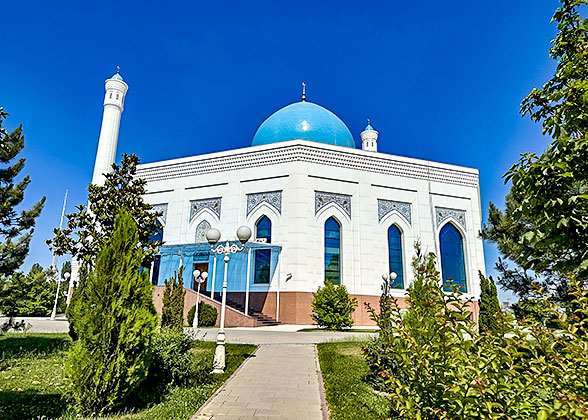
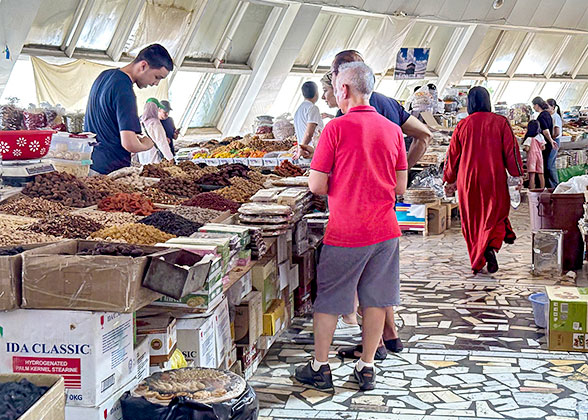 ► Dinner Suggestion (at your own expense):
► Dinner Suggestion (at your own expense):
After a short break, perhaps you can go to Besh Qozon Pilaf Center, open until 23:00, to try one of Uzbekistan’s national dishes, Plov, characterized by rice, carrot, onion, lamb, hummus, and spices stir-fried together. You’ll see an impressive cauldron used to prepare Plov, which is 2 meters (7 feet) in diameter and able to serve 3 tons of rice at one time. Watch the chefs constantly stirring the ingredients to perfection while waiting, and then enjoy the fruits of their labor! Since Plov was originally created to provide enough energy for merchants along the ancient Silk Road, it may taste a bit greasy, but it always goes well with a cup of lemon tea.
Average Cost per Person: UZS 50,000-100,000 (USD 4-8)
Address: 8685+JVC, Nurafshon ko'chasi, Tashkent, Uzbekistan
Meals: Breakfast
Accommodation: Wyndham Tashkent (4 stars) or similar
Continue our journey to the Chorsu Bazaar, a sensory wonderland filled with fresh produce, aromatic spices, and exquisite handicrafts. When wandering through the spice stalls, you might be drawn to volcanic clay stones, which are great for calcium supplements and have a slightly salty taste. Try them if you are bold enough! Then take a subway to the city center with our guide, where you’ll admire stations with various themes. One standout is the Kosmonavtlar station, featuring a ceiling design inspired by the Milky Way, and the walls are embellished with portraits of astronomer Ulugh Beg and astronaut Yuri Gagarin, which is regarded as the most beautiful station in the city.
After relaxing at Independence Square (Mustakillik Square) and Amir Timur Square, we’ll transit to the State Museum of Applied Art to learn about handicrafts from different regions of Uzbekistan, including woodwork, porcelain, and jewelry. Bukhara’s suzani embroidery is a highlight, and you can take in traditional ethnic attire made by various techniques like chain stitch and satin stitch. Today’s sightseeing is all over here, and we’ll transfer you to the hotel.

Khast-Imam Complex, Tashkent

Chorsu Bazaar, Tashkent
After a short break, perhaps you can go to Besh Qozon Pilaf Center, open until 23:00, to try one of Uzbekistan’s national dishes, Plov, characterized by rice, carrot, onion, lamb, hummus, and spices stir-fried together. You’ll see an impressive cauldron used to prepare Plov, which is 2 meters (7 feet) in diameter and able to serve 3 tons of rice at one time. Watch the chefs constantly stirring the ingredients to perfection while waiting, and then enjoy the fruits of their labor! Since Plov was originally created to provide enough energy for merchants along the ancient Silk Road, it may taste a bit greasy, but it always goes well with a cup of lemon tea.
Average Cost per Person: UZS 50,000-100,000 (USD 4-8)
Address: 8685+JVC, Nurafshon ko'chasi, Tashkent, Uzbekistan
Meals: Breakfast
Accommodation: Wyndham Tashkent (4 stars) or similar
Day 11 4 Hours Train to Kokand, Visit Khudoyar-Khan Palace, Drive to Fergana & Stop by Rishton
After breakfast, you’ll be transferred to the railway station for a 4-hour train to Kokand, the largest commercial hub of Central Asia in the 19th century, thanks to its thriving cotton industry. Upon your arrival, our local driver and the guide will pick you up and lead you to a UNESCO World Heritage site, Khudoyar-Khan Palace, home to the last governor of the Khanate of Kokand (1514-1876). Constructed by 80 architects and over 16,000 laborers using thousands of hand carts, the palace allures visitors with its magnificent appearance covered with geometric and floral pattern tiles.
Our next stop is the Norbut-Biy Madrassah, the largest religious center in Kokand. Despite the exquisite wood carvings on its front door, you won’t see any decoration in its indoor space, which creates a tranquil environment for students to study the Quran, Hadith, and Arabic. The following one is the Modari Khan Mausoleum, where Umar Khan’s female relatives are buried. The interior vault is covered in ribbed helix patterns, considered one of the oldest elements in the region before the rise of Islam.
Next, we’ll drive 40 minutes to Rishton, once a major ceramic-making center along the ancient Silk Road for centuries, boasting the blue-glazed ishkor plates, and today you may see the beautiful ceramics and witness their production process. Afterward, our driver will escort you to the hotel in Fergana.
Meals: Breakfast
Accommodation: Hotel Asia Fergana (4 stars) or similar
Our next stop is the Norbut-Biy Madrassah, the largest religious center in Kokand. Despite the exquisite wood carvings on its front door, you won’t see any decoration in its indoor space, which creates a tranquil environment for students to study the Quran, Hadith, and Arabic. The following one is the Modari Khan Mausoleum, where Umar Khan’s female relatives are buried. The interior vault is covered in ribbed helix patterns, considered one of the oldest elements in the region before the rise of Islam.
Next, we’ll drive 40 minutes to Rishton, once a major ceramic-making center along the ancient Silk Road for centuries, boasting the blue-glazed ishkor plates, and today you may see the beautiful ceramics and witness their production process. Afterward, our driver will escort you to the hotel in Fergana.
Meals: Breakfast
Accommodation: Hotel Asia Fergana (4 stars) or similar
Day 12 Fergana - Ahmad Al-Fargoni Monumental Complex - Margilan - Yodgorlik Silk Factory - Andijan
Today, we’ll explore Fergana, a city nestled deep in the Tianshan Mountains, where the Syr Darya River nurtures the fertile land to grow crops and fruits. Begin your day at Ahmad Al-Fargoni Monumental Complex, which was built to commemorate this medieval astronomer and mathematician, and you can take memorable photos with its huge white arch or soak up the serene atmosphere.
Then move forward to Margilan, the center of Uzbekistan’s silk industry. Our guide will show you around the Said Ahmad-khoja Madrasah, which has evolved into a workshop specializing in weaving, gold embroidery, and wood carving, and you’ll observe how artisans weave a silk carpet. Additionally, Yodgorlik Silk Factory is another place to delve into the entire silk textile production process, from extracting silk from silkworm cocoons to crafting the fabulous khan-atlas, handmade silk fabric with single-sided patterns. The dyeing house may arouse your interest, where you’ll see piles of pomegranate skins, onion skins, and nuts, all of which are boiled to dye silk in red, yellow, and brown.
Afterward, the driver will transfer you to Andijan, an hour’s drive away, which is the hometown of Muhammad Babur, the founder of the Mughal Empire (1526-1857). You’ll visit the Babur Memorial Park and Babur Literary Museum to unveil his life. Finally, you’ll enjoy a private transfer to the local hotel.
Meal: Breakfast
Accommodation: Toshkent Hotel Andijan (4 stars) or similar
Then move forward to Margilan, the center of Uzbekistan’s silk industry. Our guide will show you around the Said Ahmad-khoja Madrasah, which has evolved into a workshop specializing in weaving, gold embroidery, and wood carving, and you’ll observe how artisans weave a silk carpet. Additionally, Yodgorlik Silk Factory is another place to delve into the entire silk textile production process, from extracting silk from silkworm cocoons to crafting the fabulous khan-atlas, handmade silk fabric with single-sided patterns. The dyeing house may arouse your interest, where you’ll see piles of pomegranate skins, onion skins, and nuts, all of which are boiled to dye silk in red, yellow, and brown.
Afterward, the driver will transfer you to Andijan, an hour’s drive away, which is the hometown of Muhammad Babur, the founder of the Mughal Empire (1526-1857). You’ll visit the Babur Memorial Park and Babur Literary Museum to unveil his life. Finally, you’ll enjoy a private transfer to the local hotel.
Meal: Breakfast
Accommodation: Toshkent Hotel Andijan (4 stars) or similar
Day 13 Transfer to Osh, Kyrgyzstan: Visit Museum Sulaiman-Too & Local Bazaar; Fly to Bishkek
We’ll say goodbye to Uzbekistan and head to Kyrgyzstan after breakfast. Traversing the largest checkpoint between the two countries may take about 1-2 hours or even more, but the anticipation will fuel your excitement! Once you pass through customs, our driver and the guide in Osh will warmly welcome you. In the following days, feast your eyes on Kyrgyzstan’s unspoiled beauty, with its lush grasslands, pristine lakes, and traditional yurts.
Your adventure kicks off with a visit to the Museum Sulaiman-Too, which looks like a sun hat carved into the mountain. Here, you can probe into the region’s cultural and religious history through ancient artifacts from the 11th century, restored cave dwellings, and scenes of Shamanism rituals. Appreciating vibrant murals in the surrounding caves and enjoying the stunning views of Osh City from the summit are also must-do activities. In the afternoon, let’s go to a local bazaar, where many stalls are transformed from containers.
After that, you’ll take a 45-minute flight to Bishkek and then check into the local hotel.
Meals: Breakfast
Accommodation: Ramada by Wyndham Bishkek Centre Hotel (4 stars) or similar
Your adventure kicks off with a visit to the Museum Sulaiman-Too, which looks like a sun hat carved into the mountain. Here, you can probe into the region’s cultural and religious history through ancient artifacts from the 11th century, restored cave dwellings, and scenes of Shamanism rituals. Appreciating vibrant murals in the surrounding caves and enjoying the stunning views of Osh City from the summit are also must-do activities. In the afternoon, let’s go to a local bazaar, where many stalls are transformed from containers.
After that, you’ll take a 45-minute flight to Bishkek and then check into the local hotel.
Meals: Breakfast
Accommodation: Ramada by Wyndham Bishkek Centre Hotel (4 stars) or similar
Day 14 Hike in Ala Archa National Park; Drive 3 Hours to Chon Kemin National Park
In the morning, go for a hike in the Ala Archa National Park, where cool mountain air awaits to invigorate your spirit! Located beneath the towering Tien Shan Mountains, the park is filled with spectacular snow-capped peaks, thundering waterfalls, and lush fir trees. As you traverse different landscapes, keep an eye out for rare wildlife like the bluebird or the ancient juniper trees. We’ll pause halfway for a picnic lunch surrounded by nature.
 Tips:
Tips:
1. Even in summer, mountain temperatures can be chilly, so we advise wearing warm and windproof clothes.
2. The terrain is uneven with no road signs, so follow your guide closely. Since there are no supply points along the way, it’s better to bring enough water.
3. Wear your sunglasses and anti-slip shoes to cope with the dazzling snowcaps and melted snow as the temperature rises.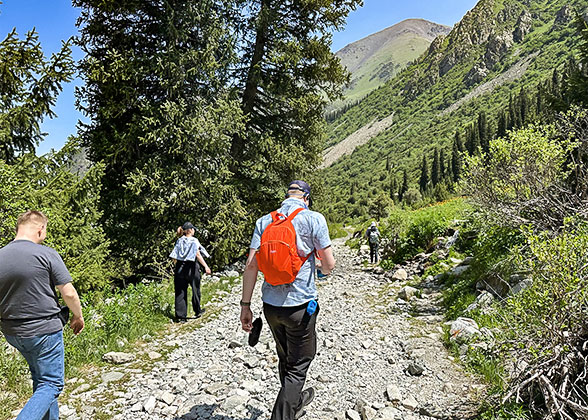
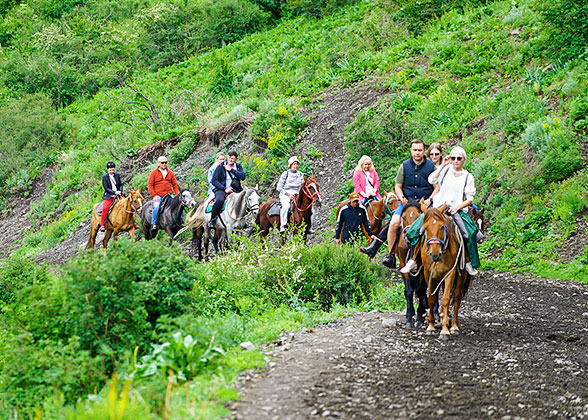 Next, travel to the Chon Kemin National Park, where diverse landscapes, from semi-deserts to icy glaciers, will take your breath away. In the valley’s open areas, you’ll see some large settlements that showcase the essence of idyllic Kyrgyzstan life. Every corner of this park offers an exciting chance to connect with nature, so we leave the afternoon for you to explore on your own. You can roam freely, watching the river wind through fir trees into the Chu River, or try to spot the rare golden eagle; rent a horse to ride through the colorful flower tapestry and experience the nomadic lifestyle. Are you looking for a more adventurous activity? Try canyon rafting to navigate the rushing waters! After a full day, check into a local guest house to stay overnight.
Next, travel to the Chon Kemin National Park, where diverse landscapes, from semi-deserts to icy glaciers, will take your breath away. In the valley’s open areas, you’ll see some large settlements that showcase the essence of idyllic Kyrgyzstan life. Every corner of this park offers an exciting chance to connect with nature, so we leave the afternoon for you to explore on your own. You can roam freely, watching the river wind through fir trees into the Chu River, or try to spot the rare golden eagle; rent a horse to ride through the colorful flower tapestry and experience the nomadic lifestyle. Are you looking for a more adventurous activity? Try canyon rafting to navigate the rushing waters! After a full day, check into a local guest house to stay overnight.
Meals: Breakfast
Accommodation: Kok-Archa Guesthouse, Chon Kemin
1. Even in summer, mountain temperatures can be chilly, so we advise wearing warm and windproof clothes.
2. The terrain is uneven with no road signs, so follow your guide closely. Since there are no supply points along the way, it’s better to bring enough water.
3. Wear your sunglasses and anti-slip shoes to cope with the dazzling snowcaps and melted snow as the temperature rises.

Ala Archa National Park, Kyrgyzstan

Horse Riding to Chon Kemin National Park
Meals: Breakfast
Accommodation: Kok-Archa Guesthouse, Chon Kemin
Day 15 Drive to Cholpon Ata by Issyk-Kul Lake, Visiting Nomad Museum & Museum of Petroglyphs en Route
After breakfast, let’s go to Cholpon Ata by car for about 3 hours. It’s located on the north shore of the Issyk-Kul Lake, the largest plateau lake in Asia. The lake is impressive with its sheer size and blue-green water glistening under the sun, reflecting the surrounding snow-capped mountains. What’s amazing is that it stays unfrozen even in winter’s harshest cold of -20°C (-4°F) due to its high salinity!
Along the way, we’ll stop at the Nomad Museum, where you can see saddles, equestrian equipment, and traditional clothing. The Kyrgyz ethnic attire is often made of cotton and felt, designed in a layered and simple style to effectively meet the needs of the nomadic life and resist the afternoon heat in summer. Men wear loose shirts and trousers to avoid hindering hunt, and add a robe, Chapan, in winter for warmth; and women wear beldemchi, a skirt with a front slit, over a robe or dress embroidered with floral patterns.
Our guide will also accompany you to visit the open-air Museum of Petroglyphs, which has a collection of rock carvings that depict goats, deer, camels, and hunters dating back to 4,000-2,000 BC. Before the sun causes them to further fade, seize the time to see these incredible artworks! In addition, the path above the museum offers a sweeping view of the Issyk-Kul Lake.
Upon arrival at Cholpon Ata, you’ll check into a local hotel and spend the rest of the day on your own. This resort has been popular since the Soviet era, and the golden beaches, leisurely benches, and refreshing water invite you to find your own way. For those who prefer water activities, consider sailing or kayaking to the heart of the lake; feel the cool water ripple beneath, and dip your fingers into its depths.
Meals: Breakfast
Accommodation: Kapriz Issyk Kul Resort, Cholpon Ata (3 stars) or similar
Along the way, we’ll stop at the Nomad Museum, where you can see saddles, equestrian equipment, and traditional clothing. The Kyrgyz ethnic attire is often made of cotton and felt, designed in a layered and simple style to effectively meet the needs of the nomadic life and resist the afternoon heat in summer. Men wear loose shirts and trousers to avoid hindering hunt, and add a robe, Chapan, in winter for warmth; and women wear beldemchi, a skirt with a front slit, over a robe or dress embroidered with floral patterns.
Our guide will also accompany you to visit the open-air Museum of Petroglyphs, which has a collection of rock carvings that depict goats, deer, camels, and hunters dating back to 4,000-2,000 BC. Before the sun causes them to further fade, seize the time to see these incredible artworks! In addition, the path above the museum offers a sweeping view of the Issyk-Kul Lake.
Upon arrival at Cholpon Ata, you’ll check into a local hotel and spend the rest of the day on your own. This resort has been popular since the Soviet era, and the golden beaches, leisurely benches, and refreshing water invite you to find your own way. For those who prefer water activities, consider sailing or kayaking to the heart of the lake; feel the cool water ripple beneath, and dip your fingers into its depths.
Meals: Breakfast
Accommodation: Kapriz Issyk Kul Resort, Cholpon Ata (3 stars) or similar
Day 16 Cholpon Ata - Burana Tower - Bishkek; Visit Old Square, Oak Park, Ala-Too Square, Victory Square
In the morning, we’ll drive 4 hours to Burana Tower, built in the 11th century with red bricks. It’s the only remnant of the Balasagun, the capital of the Kara-Khanid Khanate (999-1211) and a key Silk Road trading hub. Climbing to the top of it, you can overlook the whole Balasagun ruins and enjoy the views of the surrounding valleys. Just be careful of the narrow and steep ladder. If your body isn’t up for it, exploring the quirky stone tablets with humorous character faces will also be entertaining.
Next, let’s drive to Bishkek and immerse yourself in the city’s Soviet past. Meandering through the Old Square, our guide will show you around Oak Park, where you’ll encounter statues of significant historical figures like Lenin and Marx. Sometimes, the serene atmosphere comes alive with vintage red trams navigating through the tree-lined street and children enjoying roller skating. Our next stop is Ala-Too Square, where the statue of Kyrgyz hero Manas stands tall against the backdrop of snow-capped mountains. Another crucial historic landmark is Victory Square, where the Eternal Flame has been burning since 1985 to commemorate WWII heroes. When passing by the White House and the National Opera and Ballet Theatre of Abdylas Maldybayev, you can take memorable photos to conclude the day. Finally, you’ll be whisked to the hotel for a rest.
Meals: Breakfast
Accommodation: Ramada by Wyndham Bishkek Centre Hotel (4 stars) or similar
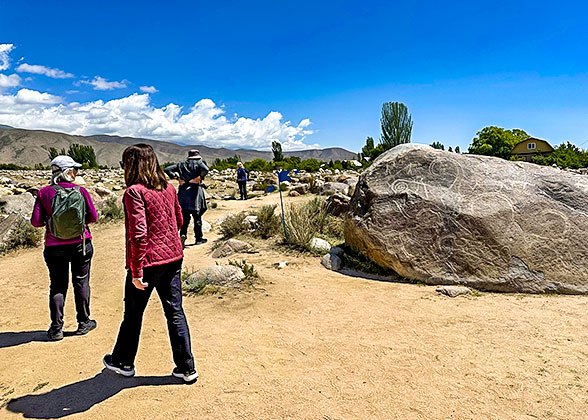
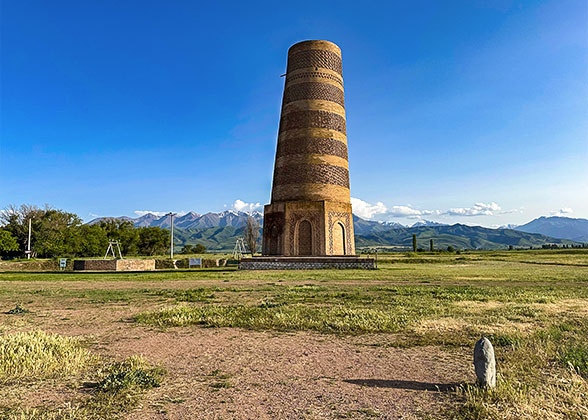
Next, let’s drive to Bishkek and immerse yourself in the city’s Soviet past. Meandering through the Old Square, our guide will show you around Oak Park, where you’ll encounter statues of significant historical figures like Lenin and Marx. Sometimes, the serene atmosphere comes alive with vintage red trams navigating through the tree-lined street and children enjoying roller skating. Our next stop is Ala-Too Square, where the statue of Kyrgyz hero Manas stands tall against the backdrop of snow-capped mountains. Another crucial historic landmark is Victory Square, where the Eternal Flame has been burning since 1985 to commemorate WWII heroes. When passing by the White House and the National Opera and Ballet Theatre of Abdylas Maldybayev, you can take memorable photos to conclude the day. Finally, you’ll be whisked to the hotel for a rest.
Meals: Breakfast
Accommodation: Ramada by Wyndham Bishkek Centre Hotel (4 stars) or similar

The Open-air Museum of Petroglyphs at Cholpon Ata

Burana Tower, Kyrgyzstan
Day 17 Departure from Bishkek of Kyrgyzstan, Airport See-off
Today is the last day of your Uzbekistan Turkmenistan Kyrgyzstan tour. According to your departure flight, you’ll be escorted to the airport by the driver. Wish you a smooth journey home!
If you want to take more time to explore Central Asia and extend your trip to Kazakhstan and Tajikistan, please feel free to contact our travel consultants!
Meals: Breakfast
If you want to take more time to explore Central Asia and extend your trip to Kazakhstan and Tajikistan, please feel free to contact our travel consultants!
Meals: Breakfast
Expand All
Collapse All
This trip can be customized to meet your individual needs!
Itineraries you may also like:
 10 Days Ashgabat - Darvaza - Kunya Urgench - Khiva - Bukhara - Samarkand - Tashkent
10 Days Ashgabat - Darvaza - Kunya Urgench - Khiva - Bukhara - Samarkand - Tashkent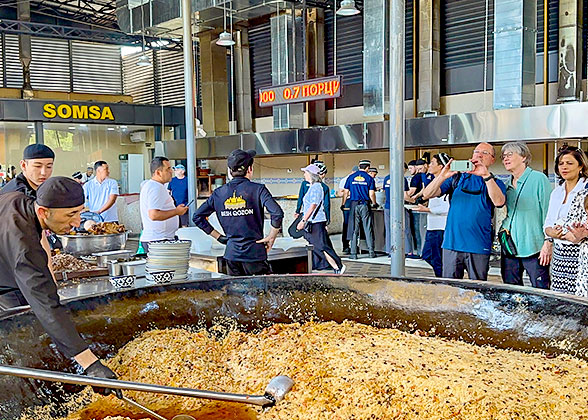 26 Days Almaty - Saty - Jeti-Oguz - Bishkek - Tashkent - Khujand - Panjakent - Dushanbe - Kalai-Khumb - Termez - Samarkand - Bukhara - Mary - Ashgabat - Darvaza - Khiva - Tashkent
26 Days Almaty - Saty - Jeti-Oguz - Bishkek - Tashkent - Khujand - Panjakent - Dushanbe - Kalai-Khumb - Termez - Samarkand - Bukhara - Mary - Ashgabat - Darvaza - Khiva - Tashkent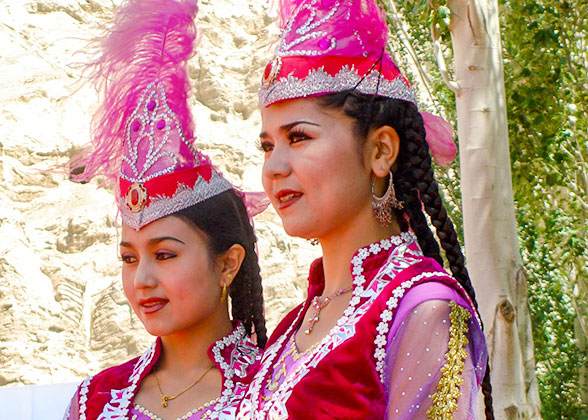 21 Days Tashkent - Urgench - Khiva - Bukhara - Samarkand - Penjikent - Seven Lakes - Penjikent - Osh - Karakol - Jeti-Oguz - Karakol - Basshi - Almaty
21 Days Tashkent - Urgench - Khiva - Bukhara - Samarkand - Penjikent - Seven Lakes - Penjikent - Osh - Karakol - Jeti-Oguz - Karakol - Basshi - Almaty
